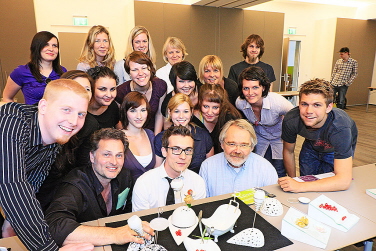Combining creativity and molecular cuisine: Original, multipurpose tableware and "tools"
Cooperation project between Krefeld and Düsseldorf design students and avant-garde gourmets in Krefeld
(HN/D UAS) Tableware and implements for the molecular kitchen were developed by 20 design students from Krefeld and Düsseldorf in a joint project. The ceramics, porcelain and glass designers at Niederrhein University and the jewellery and implement designers at Düsseldorf University of Applied Sciences cooperated with the newly opened "Bertels" Bistro in the Salvea Wellness Centre in Krefeld. Head chefs Hans Bertels and Dominik Grzeschik wanted to prepare and present their delicacies consonant with their function, yet also full of playful fantasy. The design students provided the concepts and drafts to this end.
Deborah Unger and Arne Hagen from Krefeld, for instance: They designed a table set consisting of bowls, small plates and lids, plus boards into which they can be inserted, offering no less than 448 combinations. "It's just what we needed because we want to work as creatively as possible", enthused young chef Dominik Grzeschik. The violet colouring of the base boards came about through light and oxidation. Cutlery is replaced by tools which make it easier for guests to wrap, say, candy floss around tasty morsels than would be possible with normal forks.
The molecular kitchen turns out small yet elaborate dishes which are both optically appealing and prepared in a highly experimental manner. Cooking is regarded here as being a mixture of process engineering and unlimited fantasy, with long cooking times at below 100° C, some dishes are prepared with liquid nitrogen whilst others use alginates. This means that the food needs to be prepared near to the diners and enables a celebration at the table - with crockery and cutlery designed especially for the purpose. What one might call a dining experience taken to another dimension.
The project is now the fifth collaboration between the two design faculties under the supervision of graduate designer Herbert Schulze (Düsseldorf) and Prof. Gerhard Hahn (Krefeld).
